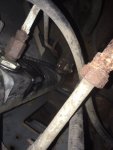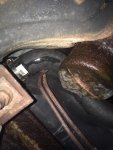Hello everyone, this is my first post. I jsut bought my 92' bronco in July. I was told that truck has been sitting for a while. Since I bought I have replaced the alternator, battery, break line and calipers. Windshield washer motor(its all pretty but still doesnt work, I believe the spray nozzles themselves are clogged), the accessory belt and it has been tuned. It still has a hard time around 20-45 mph as if it wants to stall at some point. This is a random event as in I can correlate it with just one thing but occurs every time I drive, it also could be the cold weather, I don't know.I am just getting into cars and repairs.
The reason why I am posting is because It seems that I have coolant leak from the lower radiator hose. However, it does appear that there is liquid coming from upper hose as well. I would like this to be my first project that I attempt to do on my truck. I would like to know what you guys think. The leak tends to occur after my truck cools down. I read on another post that this may be an end cap? Let me know what you think. The first picture is looking down on the radiator and the second is from underneath the truck.


The reason why I am posting is because It seems that I have coolant leak from the lower radiator hose. However, it does appear that there is liquid coming from upper hose as well. I would like this to be my first project that I attempt to do on my truck. I would like to know what you guys think. The leak tends to occur after my truck cools down. I read on another post that this may be an end cap? Let me know what you think. The first picture is looking down on the radiator and the second is from underneath the truck.


